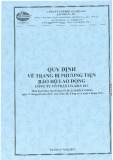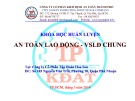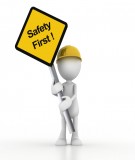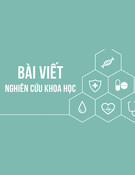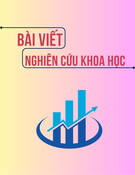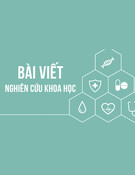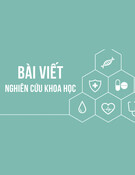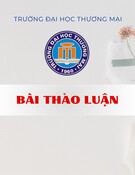
http://www.iaeme.com/IJM/index.as 40 editor@iaeme.com
International Journal of Management (IJM)
Volume 8, Issue 4, July– August 2017, pp.40–51, Article ID: IJM_08_04_006
Available online at
http://www.iaeme.com/ijm/issues.asp?JType=IJM&VType=8&IType=4
Journal Impact Factor (2016): 8.1920 (Calculated by GISI) www.jifactor.com
ISSN Print: 0976-6502 and ISSN Online: 0976-6510
© IAEME Publication
AN INNOVATIVE PROCESS FOR THE
QUALIFICATION AND EVALUATION OF
OCCUPATIONAL RISK MANAGEMENT UNDER
THE OHSAS 18001 STANDARD
Gambera Vanessa
Department of Economics and Business, University of Catania,
Corso Italia 55- 95129, Catania
ABSTRACT
Accidents in the workplace over the last few years have registered a reassuring
downturn due to the development of a safety policy in workplaces which has allowed a
significant reduction in accidents, incidents or occupational illnesses occurring in the
workplace. Workplace safety is a top priority in welfare policies and the company plays
a central role in development policies. Specific legislation, both compulsory and
voluntary is important, in order to raise companies’ awareness of the spread of a culture
of safety.
This paper aims at studying the implementation of an innovative process for the
qualification and evaluation of safety standards for European and non-European
service providers in the handling of contracts, governed by Legislative Decree no. 81
of 2008, known as the Safety Code, the binding legislation on safety in force in Italy.
The analysis is conducted through the study of the process of purchasing service
supplies, considering the impact that this process has on the protection of health and
safety at workplaces.
For this purpose, the process of implementing a health and safety management
system in the workplace, certified according to the OHSAS 18001: 2007 standard was
analyzed within a primary electronics industry company, located in Eastern Sicily. A
suitable procedure was therefore identified to be included in the company’s
management manual, so as to standardize the technical evaluation procedure of the
European and non-European service providers which the company operates with, in the
search for the Safety requirements that these suppliers have to possess. This procedure
makes it possible to efficiently evaluate and qualify service providers in the absence of
legislative indications on contract management with European and non-European
suppliers.
Key words: Checklist, Safety Requirements, Risk Management, Procedure,
Implementation.

Gambera Vanessa
http://www.iaeme.com/IJM/index.as 41 editor@iaeme.com
Cite this Article: An Innovative Process for the Qualification and Evaluation of
occupational Risk Management under the OHSAS 18001 Standard. International
Journal of Management, 8 (4), 2017, pp. 40–51.
http://www.iaeme.com/ijm/issues.asp?JType=IJM&VType=8&IType=4
1. INTRODUCTION
International health and safety standards have emerged since 1996. In that year, in a workshop
on occupational health and safety organized at Geneva by ISO, the majority of participants
stated that they were opposed to establishing laws on the matter [1]. In November 1998, the
British Standard Institution (BSI) advanced its request to set up a Technical Committee,
consisting of the major national regulatory bodies, certification bodies and specialist
consultants, so that it could outline a management model for health insurance and for safety in
the workplace with universal validity and certifiable by a third party.
Numerous partners participated in the drafting of the specification. The group's work
resulted in the OHSAS 18001 "Occupational Health & Safety Assessment Series".
The Occupational Health and Safety Assessment Series 18001, OHSAS 18001, was
formulated by international certifying bodies based on British Standards 8800 (BS 8800).
OHSAS 18001 was first published in 1999 in conformity with quality (ISO 9001) and
environmental (ISO 14001) management systems standards in order to facilitate an integration
of the three systems [2]. The Integrated Management System (IMS) is known as a system that
merges the components of business into one system. IMS implementation includes ISO 9001
Quality Management, ISO 14001 Environment Management and Occupational Health and
Safety Management OHSAS 18001 but it is not just limited to these standards [3].
The objectives of OHSAS 18001 include creating and maintaining a safe working
environment while protecting and maintaining the good health of the workers. The
implementation and certification of OHSAS 18001 systems have been an important undertaking
for many organizations and have become a widespread phenomenon around the world [4].
The safety management system is designed to deal with occupational health and safety in a
systematic way by the following activities:
• setting company safety targets and objectives;
• designating roles and responsibilities for safety personnel;
• planning and performing hazard mitigation;
• monitoring, measuring, and improving the on-going system and its effectiveness.
Measurement is a key step in any management process and forms the basis of continual
improvement. If measurement is not carried out correctly, the effectiveness of the Safety
Management Systems (SMS) is undermined and there is no reliable information to inform
managers how well the health and safety risks are controlled [5].
The occupational health and safety standard OHSAS 18001 has gained considerable
acceptance worldwide, and firms from diverse sectors and of varying sizes have implemented
it.
The OHSAS 18001 is applicable to any organisation that wishes to:
• establish an SMS to eliminate or minimise risk to employees and other interested parties who
may be exposed to Occupational Health Safety (OHS) risks associated with its activities;
• implement, maintain and continually improve an SMS;
• assure itself that the system complies with its stated OHS policy;
• demonstrate compliance with this standard to others.

An Innovative Process For The Qualification and Evaluation of occupational Risk Management Under
The OHSAS 18001 Standard
http://www.iaeme.com/IJM/index.as 42 editor@iaeme.com
From an institutional perspective, OHSAS certification helps a firm signal legitimacy
to major customers. Previous research showed that ISO 9001 and 14001 were both adopted
partially for legitimating reasons, hence it is likely that OHSAS certification would have a
similar effect [6].
OHSAS 18001 is interpreted as a signal of a firm’s commitment to health and safety
management. Given the increasing demand for organizations to at least appear to meet
expectations about health and safety, such pressure could be a powerful driver toward
certification. If this perspective is correct, OHSAS certification improves the firm’s sales
performance, since certification may meet customer safety requirements. However, if the only
benefit from certification is the ability to signal, then all other components of operational
performance would remain unchanged after certification. Based on this perspective, the process
of certification would not alter production processes or the production system’s reliability. The
primary benefit of certification would be increased sales once certification was granted [7].
modulo
In Italy, the specific legislation on occupational health and safety is covered by the Safety
Code at Work. The legislative decree no. 81 of 9 April 2008, entered into force on May 15,
2008 with the implementation of Art. 1 of law no. 123 of 3 August 2007 [8]. This decree covers
all matters relating to occupational health and safety, and has the advantage of providing well-
structured definitions that facilitate its analysis. Detailed descriptions of workplaces, specific
norms, are schematized in such a way that the reader can find clear, complete and incisive
answers [9].
The implementation of a Health and Safety Management System in the Workplace
should be considered as a process of implementing the legal requirements imposed by the
binding legislation on health and safety in the workplace as well as the continuous improvement
of management processes and assessment of all the risks associated with the organization. In
fact, in some small and medium-sized companies, it has been found that many elements of the
system, included in the OHSAS 18001 scheme and implemented in the company, comply with
the binding regulations on safety management [10].
The comparison of the requirements requested by OHSAS 18001 with the specifications of
the legislative measures makes an overlapping between voluntary legislation and binding
legislation possible. So from the comparison between OHSAS 18001: 07 and Legislative
Decree 9 April 2008, no. 81 the implementation of the binding norms can be verified [11].
2. ITALIAN COMPULSORY LEGISLATION AND THE OHSAS
18001:2007 STANDARD
The legislative decree D. LGS 81/2008, Art. 26, governs and dictates the legal requirements
sought by the service providers, both in the case of contracts, of works and of delivery, and
when the execution of a work by a supplier takes place within temporary or mobile sites which
the Safety Code devotes the entire Chapter IV to.
The starting point of the analysis carried out in this paper is the above-mentioned legislation
with contextual definition of the essential safety standards for outsourcing jobs to service
providers.
These requirements are in fact of a compulsory nature. The purpose of the standard is to
establish a series of relationships and obligations for the persons involved in the contract to
ensure the protection of workers' health and safety. Art. 26 is aimed at:
• Verifying the professional technical competence of the company which the contract is entrusted
to. The legislator therefore stipulates that the person who the work is entrusted to has all the
legislative requirements envisaged in the decree. Therefore, the supplier is required to provide

Gambera Vanessa
http://www.iaeme.com/IJM/index.as 43 editor@iaeme.com
a statement declaring they have such requirements, a declaration that is relevant to the D.P.R.
445/2000 according to Art. 47;
• informing employers and self-employed workers, then the contractor about the risks to the
environment where they are to operate;
• cooperating for the implementation of measures to prevent the risks of accidents during the
work carried out under the contract;
• coordinating prevention and protection measures in order to eliminate the risks of interference
between the work of the various companies involved in the execution of the overall work;
• developing a single document for all companies to assess the risks of interference.
The risk of interference is a critical element to be considered. This can be defined as any
risk arising from working, in a particular place, where other operators are already engaged in a
work activity. With exception to the general obligations of information, cooperation and
coordination which all operators are bound by, the obligations envisaged in order to eliminate
the risks of interference are attributed to the employer who has the legal capacity of the
workplace where the contract is being carried out. The latter is given the task of drafting the
Document of Risk Assessment and Interference, a dynamic document that is drawn up to
evaluate all the risks faced by the workers involved, managing the workers’ presence in the
workplace
In addition, an organization that decides to implement a Health and Safety Management
System, which can be certified on the basis of the OHSAS 18001 standard, means that a priori
it is considering the importance of legal requirements. In fact, the Health and Safety
Management System itself implies respect for the laws on health and safety. Likewise, D. LGS.
81/08 at Art. 30 subsection 5 stipulates that the OHSAS 18001 standard fully reflects the
organization and management model that complies with all legal obligations and their
continuous improvement [12].
Hence, the Health and Safety Management System can be considered as a support tool for
a company trying to comply with the law, since through the management of any activity that is
carried out following specific procedures, the legal requirements to be respected can be
considered from the start. Thus Art. 30 refers to an adopted and implemented model of
organization and management, ensuring a corporate system for the fulfilment of all legal
obligations related to:
• compliance with the structural technical standards of the law relating to equipment, installations,
workplaces, physical, chemical and biological agents;
• the risk assessment activities and the prearrangement of consequent prevention and protection
measures;
• organizational activities, such as emergencies, first aid, procurement management, periodic
safety meetings, consultations with workers' representatives;
• supervisory activities with regard to the respect of the procedures and safety instructions of the
workers;
• health surveillance activities;
• information and training activities for workers;
• the acquisition of compulsory documents and certifications by law;
• periodic testing of the application and effectiveness of the procedures adopted.
The organizational model should therefore provide for an articulation of functions that
ensure the technical expertise necessary for the verification, evaluation, management and
control of risks as well as a suitable system to penalize non-compliance with the measures
indicated in the model adopted.

An Innovative Process For The Qualification and Evaluation of occupational Risk Management Under
The OHSAS 18001 Standard
http://www.iaeme.com/IJM/index.as 44 editor@iaeme.com
3. QUALIFICATION AND EVALUATION OF EUROPEAN AND NON-
EUROPEAN SUPPLIERS
Since the early 1990s, the protection of health and safety of workers has been one of the
legislative priorities, not only in Italy but throughout Europe.
In Europe, the line of conduct is represented by the Community directives specifically
issued to protect the safety of workers. It was the goal of the European Union to try to harmonize
the different legal systems of the various member states. The Community's choice was to set up
Community directives on labour and resource management, the environment, worker
protection, the right to healthcare and the protection of workers from accidents. These
provisions were transposed in Italy through D. LGS. 626/94 and subsequently by D. LGS.
81/2008. Over the years, the most important standard-setting bodies in the world have issued
numerous provisions concerning the creation and development of voluntary systems, freely
adopted by businesses, in order to manage workers’ health and safety.
Differences in the various legal systems are a critical issue for companies that often resort to
the conclusion of a contract for the execution of work in the workplace, dealing with European
and non-European suppliers.
The management of this process within companies is divided into the following two phases:
• Handling of the Documentary Part: Identified in direct request to suppliers of documents
attesting the possession of essential requirements, i.e. safety standards in accordance with Art.
26 D.Lgs 81/08;
• Handling of work on the basis of the contract stipulated, i.e. the management of the work in the
strict sense.
In the first phase, based on the different types of the contractual counterparty which the
enterprise interfaces with, it is appropriate to ensure the procurement of documents attesting
that the essential requirements have been met.
Therefore, it is opportune to distinguish two types of suppliers:
• a service provider with a registered office in Italy: in this case it is easy to collect documentation
because the specific regulations indicate which documents are needed to carry out the
verification of the Professional Technical Assurance, whereby the requesting party collects the
necessary documentation. This can be standardized by using a procedure;
• a service provider with a registered office abroad, or a European / non-European supplier. In
this case, there are many problems arising from the absence of indications in D. LGS. 81/2008,
or any other legislation, on the procedure to be adopted to protect the health and safety of
workers when the contract is concluded with a European or non-European company.
It is necessary to take account of:
• different legislation which exists in the country where the supplier is based
• non-equivalence of the documents that the firm must acquire for the control of the professional
technical competence of the suppliers, as specified by Art. 26 of Legislative Decree 81/08;
• diversity of language, in particular the difficulty in interpreting the mother tongue which the
required documents are produced in to non-Italian suppliers.
On the basis of the above-mentioned critical issues, it may be appropriate for companies to
standardize a procurement process when the service provider is a European or extra-European
company.
Businesses supporting this process could use appropriate procedures and operating
instructions. In fact, through a procedure, the applicant could handle the document acquisition
phase by using an objective and simplified tool. In general, a procedure contains a set of actions
to be accomplished to achieve a goal. For a company with a Management System, the
procedures must necessarily be written and usually contain:



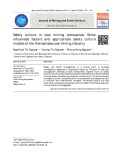
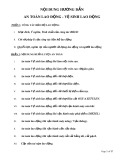
![Các biện pháp đảm bảo vệ sinh môi trường, phòng chống cháy nổ và an toàn lao động [Mới nhất]](https://cdn.tailieu.vn/images/document/thumbnail/2020/20200526/lanqiren/135x160/2231590465258.jpg)
